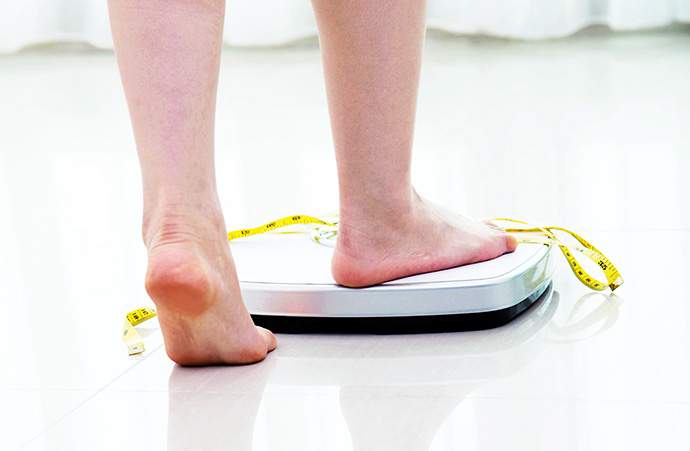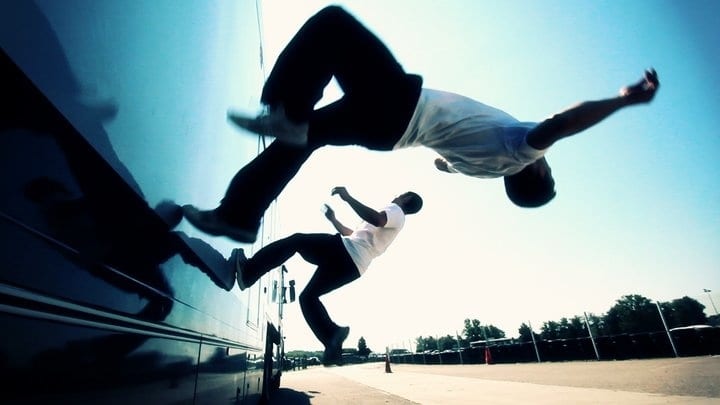This article by Dakao, who is a part of NerdFitness. Dakao is an awesome fella who does all kinds of wonderful stuff. He makes weapons, does martial arts and parkour. I find parkour fascinating, but I’ve never done it. For this reason, I requested Dakao to come up with a beginner’s manual of sorts.
People would sooner or later link NerdFitness and parkour. The rules of parkour and the NerdFitness Rebellion are very similar.
- Natural training: everything about parkour is natural, from its movements to how people should train.
- Intelligent and intentional training: parkour emphasizes on being aware of your surroundings and situations, on performing with stress. It needs as much as you can give of all these, and much more.
- Fun training: the spontaneity of parkour makes it a lot of fun. The creative thought process one goes through is very much like improvising a jazz melody or dance.
What Is Parkour?

Parkour is moving in a natural and effective way.
The word passement is used in France, for making your way past obstacles. You go through walls or anything blocking your way, in a way that fits you and the situation. There are many ways to go about it. Parkour is a way to make your movements more efficient. It can also be considered as a congenial, friendly approach to people you meet and the things you do every day. It also involves how you see natural or artificial objects in your surroundings.
How can you give your existence the most meaning and the most happiness in the easiest way possible? The NerdFitness Rebellion celebrates life in an ecstatic but responsible manner.
What Is Not Parkour?
Parkour isn’t twisting in the air, exciting stunts and flexible somersaults. Sure, they’re done to get past things that block your way, but they’re used in parkour only when they are needed.
Think about zombies. Would zombies surrender when you do a triple somersault to get past a seven-foot gap? Or would it be easier to just jump and roll?
Being successful is important. And when you look cool, that comes from being successful.
For those who haven’t attempted parkour or any intense, risky activities where you find yourself laying your body on the line, the tendency is to notice only the fantastic spectacles on video sites around the internet. They hardly get a glimpse at the obsession being put forth by parkour practitioners who undergo the harsh and rigid training beneath all that spectacle. Being safe is always important, but it is also a part of being “effective”. The amazing moves you see may be an aspect of the sport, but are very seldom needed.
Parkour is for All of You
Everybody can look for a way past a barrier.
Parkour is the mindset you have when looking for a way past the barrier. It considers the circumstance surrounding that barrier.
A traceur is what we call a parkour practitioner. One has to develop the eye of a traceur. This “eye” will help you see the various options one can use when passing an obstacle. The eye can also help you analyze the conditions. For example, is the obstacle wet? Is it hot? Is it slippery? These are things that are out of your control. And they should not be taken for granted. Not for a second. Because when you develop your traceur’s eye and become better at analyzing a situation, you can turn situations into something beneficial for you.
You can however, control what you think and how you move. How do you feel? Are you healthy enough to get past an obstacle? Do you have good balance? Are you tired or hungry? Do you need to eat? All these things can be controlled. You can take care of all these things before and during training. But probably not when you’re running away from zombies, or man-eating land predators. So always be prepared.
Control Your Life
We have a say on how life treats us.
Parkour shows this to us. Setting and prepping for 5 to 10 seconds for a jump is not hard at all. Same thing with when you try to climb down a short wall. But when you have no time to ready yourself, the pressure of the performance makes doing easy things much more difficult. Getting past any obstacle is difficult if you have no preparation.
The most difficult and most wonderful thing about parkour is that it brings out our real nature the way very few things can. If you find yourself standing on a six-foot wall, looking down, you can say anything you want. “That’s a piece of cake!” or “Crap, I ain’t doing this!”
Parkour will remind you of who you really are. You will instantly know if you stuck to your training like you should have or if you just sat around lazily the entire week. If you did train, you should have less fear that if you didn’t.
The good kind of parkour is not at all difficult to accomplish. The parkour that seeks to impress is much harder to perform.
To accomplish YouTube or movie-type parkour, the average time of you passing obstacles will be reduced from 5 to .5 seconds. That’s ten times harder to do. Everything you were taught and trained to do, like technique and movement and ways to keep yourself safe have to adjust with the change in time.
If you understood this part, let’s start shall we?
The Basics
Doing the training routines on NF forums and bodyweight routines, is a good start.
My recommendations are just that, recommendations. You know your body better than me or anyone else. Do exercises or sports that will keep you fit. That is very important.
For those who want to see what a beginner Parkour routine looks like:
You have to do ten of each: squats (leading to box jumps), push-ups, leg lifts and pull-ups.
2 sets of this three times a week will do just fine. If you find it too difficult, then decrease the repetitions for each set for the more difficult routines, until you can perform 2 sets. Take me for example. I could only do one-and-a-half pull-ups at the start. That’s perfectly fine. It’s very significant to your training though that you add ten percent more in the succeeding weeks.
Here’s a way of progression
- For each week, put in an additional one to two repetitions for every move.
- When you reach double the repetitions, which is twenty, add another set to the regimen.
- Once you reach four sets, do repetitions a bit faster and much more athletically.
I like to do five sets of twenty repetitions because I find it to be nice round number. After I reach that number, I allow myself to do harder routines.
The Meat and Potatoes
How about tackling jumps?
Look for some stairs, and try practicing using your entire physique. First try jumping a single step. Then add another step, and another. It’s important to relax, and balance yourself well, with good posture. And try landing comfortably on your toes ten times in succession. Do this before adding one more step in the following week.
For reference:
- One to two steps in easy
- Three to four steps is manageable
- Five to six is hard
- As far as I know, nobody has jumped seven.
Rehydrate after every set. This might cause you to pee frequently but’s it’s perfectly fine. It’s a good practice because it readies you for training for long hours under the scorching sun. Power drinks and soda are okay. But according to research, a quaint amount of caffeine before training improves performance.
Did you see how I avoided the subject of running? I don’t like it. I only do things I’ve put in this piece. But even if I don’t run, I can run at full speed almost three-hundred yards due to the anaerobic and aerobic nature of the exercises I mentioned. When jumping, one would need to run around three to ten steps. This equates to jogging one to two miles for a 2-hour training session. It’s perfect for parkour.
Exercising and jumping ought to be difficult, but never crippling. Consult and train with others who train. Always be careful though since there’s a lot of crappy advice you might accidentally come across. The teachings I offer is only from knowledge gathered as a self-taught traceur for three years. Some of it comes from being a martial artist for nine years. Everything I teach is what I found to be best for me, and those I coach.
Check out the videos of some moves for beginners, which are safe for practice, courtesy of American Parkour
- How to Land Correctly
- Vaulting using both hands
- Muscle Up
- Jumping with precision
More difficult moves
Check out the video with solid parkour moves.
Awesome stuff right there. Ideally, this is parkour. Flipping should be kept at a minimum, and so should monumental vaults into oblivion. Here are small effective moves to get away from zombies, if and when the zombies rise.
Accomplish the workout regimen I described above until you reach five sets of twenty repetitions. Once you reach this, you can start with harder routines.
This is important to keep in mind since many people are not fit overall. Think of it this way – don’t climb the dangerous mountains in the world if you haven’t conquered the smaller ones.
Countless repetitions during training will make your body a lot stronger and it will help your core. It will reinforce the muscles that stabilize your body. These are the muscles you hardly notice. If you pull a muscle during training, you’d need more than a day to recover. It’s always an important consideration to maintain safety and keep injuries at a minimum. You may stumble and you may fall which is why your fitness level needs to be as high as it’s ever been.
You know your body best. And you know what you can and what you can’t do.
Flipping and vaulting from bars would require dozens upon dozens of hours practicing gymnastics. Kong vaulting over a table would require hundreds upon hundreds of plyometric push-ups. This not only strengthens muscles, but also develops reflexes which can be of utmost importance when you stumble in mid-air and find yourself about to face-plant.
I have seen accidents happen.
Most of the time, these accidents happen because people get a little too confident, going over what they can actually do. Traceurs are not impressive or explosive, but they stay safe. And that to me, is most important.
If you can do these routines, then you’re ready for advanced training.
- Vertical jumping of at least 2 feet to grab a bar or ledge, transitioning to a pull-up.
- Vertical jumping to a knee tuck and landing softly of a table or bench.
- Long jumping four to six feet and ending up with good balance upon landing.
- One set of clapping push-ups.
You can do all that? Impressive! Now for the real challenge.
Expert-Level Parkour
Shoulder rolls will be most helpful in the middle of a bad parkour situation. Doing shoulder rolls well isn’t as significant as doing them spontaneously when you find yourself in an unexpected situation or off-balanced. Keep your head and hands in. Your body should be relaxed. Finish by arcing both arms and a shoulder forward in a circle around the head and rolling the butt over the head.
Please watch this video on Proper and Safe Rolling. Also, check out the rest of the videos here.
Beginner traceurs able to complete 3 sets of push-ups and pull-ups can try out DemonDrills’ videos. Do it all once. Don’t push the pace. Don’t do anything that seems impossible at the moment. Try it again the following week. Parkour’s a very personal way of expressing oneself and one’s choices. It requires a heightened awareness of one’s physique. Remember, your physique is as strong as its weakest part. Always train your entire body.
Motivate yourself
Are you ready? Check out a few more videos that should motivate and inspire you.
Once you’re done, go outside and practice. Move. Find other traceurs. Input “parkour” and “free running” as keywords in search engines and the name of your city. You’ll certainly find people who practice near you.
Long live the Rebellion!
-Dakao








